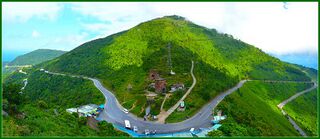Battle of Ridge 55
The Battle of Ridge 55 took place around the Western Region of Bethausia. The Western Region was filled with mountain passes and because of it, it also served as a natural barrier between the borders of Quenmin and Bethausia. In late September 2018, the President of the Socialist Republic of Burmia, Kaung Thura Kan sought to expand socialist influence into Quenmin and support the Trieuist cause by invading the Eastern borders of Quenmin, which he believed was unlikely to be defended heavily and assumed that Quenminese Forces would depend on the geographical barrier on the border for defence. However, Burmian surveyors had reported that every pass was impassable for a massive invasion force as high as 50,000 except for a single ridge that provided a large road that was enough for tanks to drive. It was nicknamed Ridge 55. The battle was the longest fought by the Commonwealth Armies in Bethausia, lasting for nearly more than 3 months.
However, one major obstacle was that the only Commonwealth base in Western Bethausia was nearby Ridge 55 and Kan sought to destroy and eliminate all Commonwealth influence from the area. The base that lied near the ridge was called Base Hiryu and most of its occupants were ZANAC troops, which numbered to only 35,000 troops. Assuming that ZANAC troops were not a large contingent in the region, Kan sought to use a strategy of using massive amounts of manpower to force the ZANAC forces in the Ridge to surrender or annihilate all forces in the Ridge. By the night of the 15th of October, massive amounts of Burmian troops attacked ZANAC lines on Ridge 55. Combined with intense shelling, the Burmian troops were confident in pushing the ZANAC forces from the Ridge. However, the ZANAC troops on Ridge 55 held back the line for the next 15 days.
By November, Burmian troops decided to flank the defending ZANAC troops by flanking on the west and eastern sections of the Ridge. However, this backfired due to the rough terrain where they were deployed at and were forced to retreat. The following week, Kan suggested that a combined infantry and armoured attack would be strong enough to drill through the enemy lines, which would then overwhelm the defenders. On November 11, swarms of Burmian troops, supported by tanks captured from Bethausian stocks attacked the Ridge on three passageways where the tanks could go through. The attack was initially successful until ZANAC infantry, supported by Type 90 tanks from the 3 RNAAR counterattacked the following morning, pushing the Burmian troops back to their initial positions and regaining the positions lost from the day before. By November 20, Burmian troops had almost exhausted their ammunition, manpower, and vehicles. On November 27, Kan ordered one last attack on the ridge, and this time placing every last of the reserves to the front lines and attacking on all fronts to overwhelm the ZANAC troops in a swift move. However, artillery batteries from the Royal Nihhonese Artillery Regiment of New Akiba were deployed within range of the Burmian forces the previous day and was in time to support the ZANAC troops on the ridge. For three days, Burmian troops attacked day and night on the Ridge until the morning of December 1, when Burmian troops retreated after exhausting manpower, armour, and other resources.
The failure of the Burmian troops to defeat the ZANAC forces on the Ridge was a disastrous attempt at hoping for an invasion of Eastern Quenmin. It was already assumed that Kaung Thura Kan's overconfidence on defeating a seemingly outnumbered force was the cause of defeat and poor tactical awareness and positioning caused numerous casualties.
